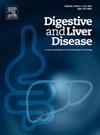肝硬化和肝细胞癌患者接受肝移植后体重组成的改变并不能预测移植后的预后。
IF 3.8
3区 医学
Q1 GASTROENTEROLOGY & HEPATOLOGY
引用次数: 0
摘要
在等待肝移植(LT)期间和手术后,骨骼肌量(肌肉减少)和脂肪组织分布的变化可作为预测生存率降低的因素。尽管如此,人体成分在肝移植前后的变化及其与患者预后的关系仍然知之甚少。目的评估等待肝移植的肝硬化和HCC患者的体重组成(骨骼肌、内脏和皮下脂肪组织)及其与移植后生存的潜在关联。方法本回顾性研究纳入2015年1月至2022年3月在帕多瓦大学医院接受肝细胞癌(HCC)治疗的成年患者。在肝移植前6个月内以及移植后3、6和12个月再次使用CT成像评估体成分。计算骨骼肌指数(SMI)、内脏脂肪组织指数(VATI)和皮下脂肪组织指数(SATI)。单因素和多因素Cox回归分析用于评估与临床结果的关联。结果共分析164例患者,其中男性85.3%,中位年龄62岁。丙型肝炎病毒(HCV)是导致肝脏疾病的主要原因,其次是酒精相关性肝硬化(20%)。HCC是69%患者的主要肝移植指征。45%的患者出现了肌肉减少症(SMI中位数:50 cm³/m²;IQR: 56.43-45.03),而VAT和SAT异常分别出现在22.4%和49.4%的患者中。肌少症患病率从肝移植前的45.1%上升到肝移植后12个月的56.1%。增值税变化稳步增加(从降税前的40.6%增加到12个月后的60%),而SAT变化保持相对不变。肝移植前体成分的改变与1年、3年或5年生存率无显著相关性(肌肉减少症:p=0.21; VATI: p=0.20; SATI: p=0.28)。同样,lt后体成分变化与生存率之间也没有发现显著关联(肌肉减少:p=0.43; VATI: p=0.50; SATI: p=0.43)。在多变量分析中,只有HCC复发(HR: 2.77; 95% CI: 1.05-7.31; p=0.038)和慢性肾脏疾病(CKD) (HR: 3.85; 95% CI: 1.06-13.92; p=0.039)成为生存的独立预测因子。在HCC患者中,没有发现身体成分及其进展与癌症复发风险之间的相关性。结论肝硬化肝细胞癌行肝移植患者常有肌肉减少和脂肪分布异常;然而,这些似乎并不影响移植后的生存或并发症。尽管在肝移植后的一年内身体成分会发生显著变化,但这些变化缺乏预后价值。因此,对于代偿性肝硬化和HCC患者进行肝移植候选性评估或肝移植后早期风险分层,可能不需要常规的身体成分评估。本文章由计算机程序翻译,如有差异,请以英文原文为准。
Alterations in body mass composition are not predictive of post-transplant outcomes in patients with cirrhosis and hepatocellular carcinoma undergoing liver transplantation.
Introduction
Changes in skeletal muscle mass (sarcopenia) and adipose tissue distribution may serve as predictor reduced survival both while awaiting liver transplantation (LT) and after the procedure. Nonetheless, how body composition evolves before and after LT and its correlation with patient outcomes remains poorly understood.
Aim
To assess body mass composition (skeletal muscle, visceral and subcutaneous adipose tissue) in patients with cirrhosis and HCC awaiting LT and their potential association with post-transplant survival.
Methods
This retrospective study included adult patients diagnosed with hepatocellular carcinoma (HCC) who underwent LT at Padua University Hospital between January 2015 and March 2022. Body composition was assessed using CT imaging within six months before LT and again at 3, 6, and 12 months after transplantation. Skeletal Muscle Index (SMI), Visceral Adipose Tissue Index (VATI), and Subcutaneous Adipose Tissue Index (SATI) were calculated. Univariate and multivariate Cox regression analyses were used to evaluate associations with clinical outcomes.
Results
A total of 164 patients (85.3% male; median age: 62 years) were analyzed. Hepatitis C virus (HCV) was the leading cause of liver disease, followed by alcohol-related cirrhosis (20%). HCC was the primary LT indication in 69% of patients. Sarcopenia was observed in 45% of the cohort (median SMI: 50 cm³/m²; IQR: 56.43–45.03), while abnormalities in VAT and SAT were identified in 22.4% and 49.4% of patients, respectively. Sarcopenia prevalence increased from 45.1% before LT to 56.1% at 12 months post-LT. VAT alterations increased steadily (40.6% pre-LT to 60% at 12 months), whereas SAT changes remained relatively unchanged. Pre-LT alterations in body composition were not significantly associated with survival at 1, 3, or 5 years (sarcopenia: p=0.21; VATI: p=0.20; SATI: p=0.28). Likewise, no significant association were found between post-LT changes in body composition and survival (sarcopenia: p=0.43; VATI: p=0.50; SATI: p=0.43). In multivariate analysis, only HCC recurrence (HR: 2.77; 95% CI: 1.05–7.31; p=0.038) and chronic kidney disease (CKD) (HR: 3.85; 95% CI: 1.06–13.92; p=0.039) emerged as independent predictors of survival. Among HCC patients, no correlation was found between body composition or its progression and the risk of cancer recurrence.
Conclusions
Sarcopenia and fat distribution abnormalities are common in patients with cirrhosis and HCC undergoing LT; however, these do not appear to influence post-transplant survival or complications. Although significant shifts in body composition occur within the first year following LT, these changes lack prognostic value. Therefore, routine evaluation of body composition may not be necessary for LT candidacy assessment or early post-LT risk stratification in patients with compensated cirrhosis and HCC.
求助全文
通过发布文献求助,成功后即可免费获取论文全文。
去求助
来源期刊

Digestive and Liver Disease
医学-胃肠肝病学
CiteScore
6.10
自引率
2.20%
发文量
632
审稿时长
19 days
期刊介绍:
Digestive and Liver Disease is an international journal of Gastroenterology and Hepatology. It is the official journal of Italian Association for the Study of the Liver (AISF); Italian Association for the Study of the Pancreas (AISP); Italian Association for Digestive Endoscopy (SIED); Italian Association for Hospital Gastroenterologists and Digestive Endoscopists (AIGO); Italian Society of Gastroenterology (SIGE); Italian Society of Pediatric Gastroenterology and Hepatology (SIGENP) and Italian Group for the Study of Inflammatory Bowel Disease (IG-IBD).
Digestive and Liver Disease publishes papers on basic and clinical research in the field of gastroenterology and hepatology.
Contributions consist of:
Original Papers
Correspondence to the Editor
Editorials, Reviews and Special Articles
Progress Reports
Image of the Month
Congress Proceedings
Symposia and Mini-symposia.
 求助内容:
求助内容: 应助结果提醒方式:
应助结果提醒方式:


